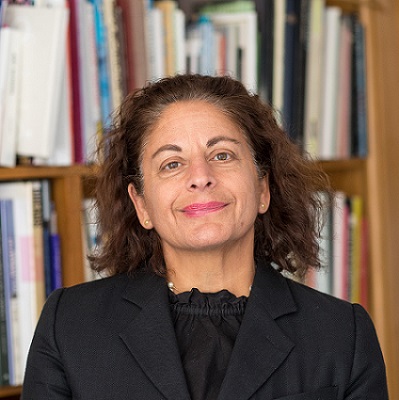Through a collaboration with Massachusetts Institute of Technology and Rhode Island School of Design, there is a new fabric in town, one that acts like a microphone, picking up sound, just like ears do. This acoustic fabric can detect the heartbeat of its wearer, converting it into electrical signals, says Anais Missakian, a RISD professor and graduate program director in textiles.
The innovation is the result of Missakian’s work with Yoel Fink, professor of materials science and joint professor of electrical engineering and computer science at MIT. Missakian has worked with Fink and a team of material scientists, engineers, textile designers and product designers to transform traditional fibers, yarns and textiles into highly sophisticated, integrated and networked devices and systems.
PBN: The human auditory system was the basis for this fabric and the way it works. Can you explain?
MISSAKIAN: Audible sound travels through the air as small pressure waves. When these waves get to our ear, the tympanic membrane, or eardrum, uses a circular layer of fibers to translate the pressure waves into mechanical vibrations. These vibrations travel through small bones into the inner ear, where the cochlea converts the waves into electrical signals that are sensed and processed by the brain.
Inspired by the human auditory system, the MIT team worked to create a fabric “ear” that would be soft, durable, comfortable and able to detect sound. The research led to two pertinent discoveries: a fabric would have to incorporate stiff, or “high-modulus,” fibers to effectively and efficiently convert sound waves into vibrations, and the design of the fiber would need to be flexible so that it could bend with the fabric and produce an electrical output. In achieving those parameters – much like the human eardrum – the textile converts sound waves into electrical signals via vibrations.
PBN: From the description in your statement of the innovation, it seems the fibers in the fabric are nearly undetectable to the wearer. Is that correct?
MISSAKIAN: The goal was to create a fabric that looks and feels like normal fabric. We wanted to change the basic aesthetics that go along with technology. Throughout history, fabrics have served a function, but comfort and beauty have played a key role in how we engage with fabrics in meaningful ways. The function does not necessarily assert itself visually and materially.
As we work further, the key will be to inhibit the fabric as we know it, as little as possible. In other words, the technology is essentially undetectable. This is possible for the first time because the technology is at the fiber level. Whereas most advanced functional fabrics consist of an ordinary fabric as substrate with technology added on, our fabrics have the potential to integrate the technology throughout the fabric.
The challenge is to create fabrics that utilize structures that protect and maximize the functional fibers, while also using traditional fibers for their physical, material and aesthetic properties and possibilities.
PBN: How long did the research, development and testing process take?
MISSAKIAN: Traditionally, fibers were made of single materials utilizing very simple geometries. In order to transform fibers into highly functional devices, three basic changes were required. First, fibers had to be made of combinations of materials, and not a single material; second, the fiber geometry and configuration had to be carefully designed; and finally, the features internal to the fiber had to be controlled at a nano scale.
Fink and his team have worked for more than two decades to extend properties in fibers and materials to make fabrics more functional. With the acoustic fiber, the researchers tested the fiber’s sensitivity to sound by attaching it to a suspended sheet of mylar. They used a laser to measure the vibration of the sheet – and by extension, the fiber – in response to sound played through a nearby speaker. The sound varied in decibel between a quiet library and heavy road traffic. In response, the fiber vibrated and generated an electric current proportional to the sound played.
It is one thing to have the fiber in hand, and a whole different endeavor to construct a fabric with the functional fiber. With the in-depth knowledge of constructed textiles at RISD, I enlisted graduate students, specifically Elizabeth Meiklejohn, to weave the fiber on a standard floor loom with conventional yarns to produce panels of drapable, machine-washable fabric.
The weaving of the fiber into a functional fabric required focused experimentation with structure and additional fibers to maximize its functionality. The fabric development took over two years as different weights, qualities and fiber mixtures were woven and tested for their functionality.
PBN: What are some of the possible applications?
MISSAKIAN: The acoustic fibers and fabrics have the potential to capture fundamental sounds, including heartbeat, breathing patterns, limb and joint movements, and blood flow. These sounds are captured and turned into pertinent data. Although other sounds might be collected at the same time, algorithms can be built and formulated to understand the context of the collected information, potentially becoming a cheaper alternative to expensive medical treatments for people, including those with heart or lung conditions.
In addition, the acoustic fabrics can record or listen to the lungs and the heart of an athlete while they are running, biking and swimming. So, the applications extend from detecting disease to reinforcing health and safety. Other applications in space and building construction are also being imagined.
PBN: What are the next steps in this innovation’s progress, with what seems like so much opportunity ahead?
MISSAKIAN: While this technology is not quite ready for commercial use, it has garnered great interest from researchers and companies, particularly in the medical and safety sectors.
Scalability and end use become the next big push. Working with industry partners to develop fabrics at an industrial scale, as well as with companies who recognize the benefits of the technology to advance existing products or develop new product categories, will be of great focus in the near future.
Susan Shalhoub is a PBN contributing writer.













